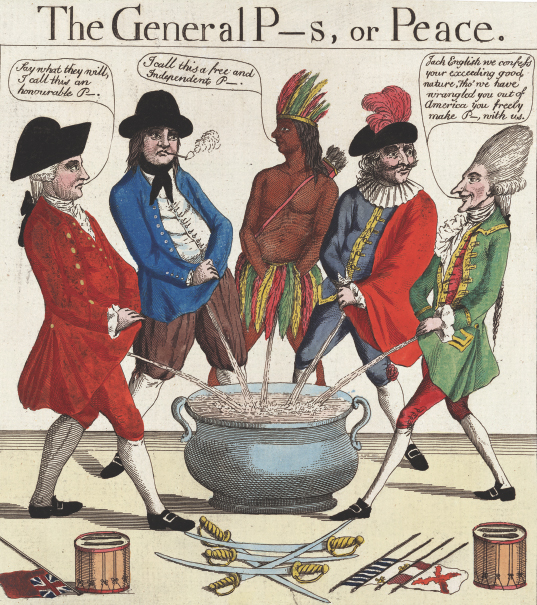The Losers and the Winners.
Printed Page 185 Chapter Chronology
The Losers and the Winners. The surrender at Yorktown spelled the end for the British, but two more years of skirmishes ensued. Frontier areas in Kentucky, Ohio, and Illinois blazed with battles pitting Americans against various Indian tribes. The British army still occupied three coastal cities, including New York, and in response, an augmented Continental army stayed at the ready, north of New York City. Occasional clashes occurred, like the ones in which Deborah Sampson saw action while cross-dressing as a male soldier.
The Treaty of Paris, also called the Peace of Paris, was two years in the making. Commissioners from America and Britain worked out the ten articles of peace, while a side treaty signed by Britain, France, Spain, and the Netherlands sealed related deals. The first article went to the heart of the matter: "His Britannic Majesty acknowledges the said United States to be free Sovereign and independent States." Other articles set the western boundary at the Mississippi River and guaranteed that creditors on both sides would be paid in sterling money, a provision important to British merchants. Britain agreed to withdraw its troops quickly, but more than a decade later this promise still had not been fully kept. Another agreement prohibited the British from "carrying away any Negroes or other property of the American inhabitants." The treaty was signed on September 3, 1783.

Treaty (Peace) of Paris, 1783
September 3, 1783, treaty that ended the Revolutionary War. The treaty acknowledged America's independence, set its boundaries, and promised the quick withdrawal of British troops from American soil. It failed to recognize Indians as players in the conflict.
News of the treaty signing was cause for celebration among most Americans, but not among the thousands of self-liberated blacks who had joined the British under promise of freedom. South Carolinian Boston King, a refugee in New York City, recalled that the provision prohibiting evacuation of black refugees "filled us with inexpressible anguish and terror." King and others pressed the British commander in New York, Sir Guy Carleton, to honor pre-treaty British promises. Carleton obliged: For all refugees under British protection for more than a year, he issued certificates of freedom — making them no longer "property" to be returned. More than 4,000 blacks sailed out of New York for Nova Scotia, Boston King and his family among them. As Carleton coolly explained to a protesting George Washington, "The Negroes in question ...I found free when I arrived at New York, I had therefore no right, as I thought, to prevent their going to any part of the world they thought proper." British commanders in Savannah and Charleston followed Carleton's lead and aided the exit of perhaps 10,000 blacks from the United States.
The Treaty of Paris had nothing to say about the Indian participants in the Revolutionary War. As one American told the Shawnee people, "Your Fathers the English have made Peace with us for themselves, but forgot you their Children, who Fought with them, and neglected you like Bastards." Indian lands were assigned to the victors as though they were uninhabited. Some Indian refugees fled west into present-day Missouri and Arkansas, and others, such as Joseph Brant's Mohawks, relocated to Canada. But significant numbers remained within the new United States, occupying their traditional homelands in areas west and north of the Ohio River. For them, the Treaty of Paris brought no peace at all; their longer war against the Americans would extend at least until 1795 and for some until 1813. Their ally, Britain, conceded defeat, but the Indians did not.
With the treaty finally signed, the British began their evacuation of New York, Charleston, and Savannah, a process complicated by the sheer numbers involved — soldiers, fearful loyalists, and refugees from slavery by the thousands. In New York City, more than 27,000 soldiers and 30,000 loyalists sailed on hundreds of ships for England in the late fall of 1783. In a final act of mischief, on the November day when the last ships left, the losing side raised the British flag at the southern tip of Manhattan, cut away the ropes used to hoist it, and greased the flagpole.